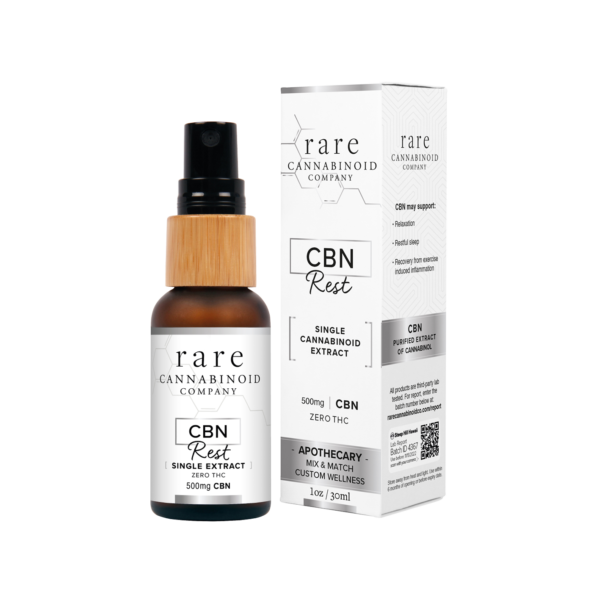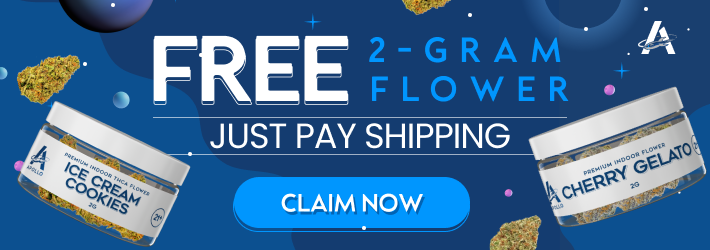The non-intoxicating cannabinoids CBG and CBN work similar to each other and to THC. Both are still in the early stages of research, lacking randomized control trials to accurately determine their effects.
Currently, CBG and CBN are thought to share potential benefits that may be pain-relieving, anticonvulsant, anti-inflammatory, fight antibiotic-resistant bacteria, anticancer, anti-psoriatic, anti-glaucoma, neuroprotective, and promote bone formation.
Side effects of CBG and CBN may include stimulating sleep and appetite. However, some users may see these as benefits. CBG can also cause dry mouth and dry eyes.
Key Differences Between CBN and CBG
CBG and CBN differ largely in their origins and use patterns. While they are naturally-occuring, they are not made by enzymes in plants or in humans. Rather, they are born of heat or light reactions from different cannabinoids.
CBG comes from applying heat to CBGA, the predecessor of most cannabinoids. Meanwhile, CBN forms from the natural aging of THC in cannabis or exposing THC to heat or UV light, even given ideal storage conditions.
Hemp can now be selectively bred into predominantly 100% CBGA and CBG plants. This hemp variety is called chemotype IV, defined by CBG-dominance. Patients report using CBG most often during the daytime for depression, anxiety, and more with anecdotal benefits.
While CBN is also found in hemp, it is present in smaller quantities because it must come from a minute amount of THC. Thus there is no pure or CBN-dominant hemp flower available. There are only extracts and commercial formulations typically suggesting nighttime dosing to promote sleep without much supporting evidence.
Characteristics
- CBN and CBG share several potential benefits and side effects
- CBG is most often taken for daytime symptom relief via oral and inhalation routes
- CBN is commonly in oral products marketed for insomnia, a claim met with healthy skepticism
- Lack of randomized controlled trials leaves many unknowns for both
Sourcing
- CBG can be found in cannabis and plentifully grown up to 100% in type IV hemp plants
- CBN is extracted from hemp and cannabis (>0.3% THC) to a much lesser degree
Legality
- CBG and CBN can be legally purchased as hemp products
- State-legal cannabis products with >0.3% THC may contain CBG and CBN as minor constituents or in major ratios
Drug Testing
- Ingestion of pure or broad-spectrum CBN or CBG doesn’t create the metabolite looked for in drug screening (THC-COOH)
- Over time, regular use of full-spectrum CBG or CBN products could cause a buildup of enough THC metabolites that can be detectable
CBN: Possible Benefits and Side Effects

CBN Benefits
In the process of becoming CBN, the compound loses the intoxicating properties of its parent, THC. However, this is advantageous for many users and allows a wider variety of patients such as the elderly to use cannabinoids comfortably.
The potential benefits of CBN are based on mixed results from small numbers of preclinical and old clinical studies. Albeit weak and inconclusive, data suggest CBN could retain several important properties of THC potentially including:
- Anticonvulsant
- Anti-inflammatory
- Antibacterial and antibiotic resistance fighter, MRSA
- Pain relief: Chronic muscle disorders, temporomandibular disorders, fibromyalgia
- Promote sleep; greater sedation in combination with THC
- Increase appetite; less effective than THC but won’t cause a high
- Reduce allergic airway disease
- Burn treatment
- Promote bone formation
- Inhibit breast cancer resistance protein
- Reduce eye pressure in glaucoma
- Neuroprotective; antioxidant in a cell model of Huntington’s
CBN Adverse Effects
Interestingly, most of the clinical studies conducted with CBN didn’t report side effects. One older study does describe adverse reactions when CBN is combined with THC, which they noted as more attributable to THC.
According to the authors of this 1980 study, there were no systemic effects from CBN or CBD alone. Taking CBN with THC, like in some of today’s dispensary products, may cause:
- Mild vagal reactions
- Anxiety
Another study went so far as to give people the largest amounts of CBN they could “comfortably tolerate.” None of the patients became uncomfortable and actually reported it as “mild and enjoyable.”
Newer follow-up studies with diverse patient populations are yet to be done on CBN alone or in combination with other cannabinoids and drugs. The short and long-term effects of CBN are largely unknown.
CBG: Possible Benefits and Side Effects

CBG Benefits
In 2023, the first clinical survey on CBG demonstrated that people commonly and effectively use CBG-dominant products for these conditions and much more:
- Anxiety
- Chronic pain
- Depression
- Insomnia and disrupted sleep
- Migraines and headaches
- Irritable bowel syndrome (IBS)
- Inflammatory bowel disease (IBD), Crohn’s, Ulcerative Colitis
CBG may also have unconfirmed potential therapeutic uses for:
- Inflammation
- Glaucoma
- Antibacterial
- Anticancer
- Metabolic syndrome
- Neuroprotection and neuromodulation such as MS, Alzheimers, Huntington’s
CBG could also be antifungal and theoretically lower eye and blood pressure a little, but all of these potential effects are far from confirmed.
RELATED: Here Are the Benefits of CBG, According to Research
CBG Adverse Effects
Authors of the 2023 survey found that the most common side effects of CBG-predominant cannabis are:
- Dry mouth
- Sleepiness
- Increased appetite
- Dry eyes and mouth
A few people also experience cognitive and withdrawal side effects, however many were also taking THC at the same time and so the authors attributed these small reports of unexpected psychoactive effects to the presence of THC.
RELATED: CBG vs. CBD: A Comparison of Benefits and Side Effects
Will CBN or CBG Show Up on a Drug Test?
Broad-spectrum, THC-free, or isolate CBG and CBN hemp products should not cause a positive result for cannabinoids on drug screens. It is also less likely with short-term use.
However, if CBN or CBG products also contain THC in any amount, even the legal 0.3% THC, then those metabolites may eventually show up in a drug test over time with frequent consumption.
Are CBN and CBG Legal?
CBN and CBG products that are derived from hemp are legal according to the 2018 U.S. Farm Bill. However, CBN and CBG found in cannabis products with more than 0.3% THC by dry weight can only be found in state-legal dispensaries.
RELATED: CBG and the FDA: Where Things Get Complicated
Conclusion: CBN vs CBG
People normally associate CBG use with daytime relief of common symptoms. Conversely, people often think CBN is only for nighttime and sleeping issues, with little research behind either one.
The reality is we can probably use both during the daytime and at night as synergistic cannabinoid regimens safely and effectively. While the science on them is in its infancy, there is likely much more than meets the eye to CBG and CBN.
References (8)
- Walsh, K. B., McKinney, A. E., & Holmes, A. E. (2021). Minor Cannabinoids: Biosynthesis, Molecular Pharmacology and Potential Therapeutic Uses. Frontiers in Pharmacology, 12, 777804. https://doi.org/10.3389/fphar.2021.777804
- Russo, E. B., Cuttler, C., Cooper, Z. D., Stueber, A., Whiteley, V. L., & Sexton, M. (2022). Survey of Patients Employing Cannabigerol-Predominant Cannabis Preparations: Perceived Medical Effects, Adverse Events, and Withdrawal Symptoms. Cannabis and Cannabinoid Research, 7(5), 706–716. https://doi.org/10.1089/can.2021.0058
- Blesching, U. (2020, September 27). Cannabis Chemotypes. Cannakeys.
- Corroon, J. (2021). Cannabinol and Sleep: Separating Fact from Fiction. Cannabis and Cannabinoid Research, 6(5), 366–371. https://doi.org/10.1089/can.2021.0006
- Nachnani, R., Raup-Konsavage, W. M., & Vrana, K. E. (2021). The Pharmacological Case for Cannabigerol. Journal of Pharmacology and Experimental Therapeutics, 376(2), 204–212. https://doi.org/10.1124/jpet.120.000340
- Jastrząb, A., Jarocka-Karpowicz, I., & Skrzydlewska, E. (2022). The Origin and Biomedical Relevance of Cannabigerol. International Journal of Molecular Sciences, 23(14), 7929. https://doi.org/10.3390/ijms23147929
- Russo, E. B. (2011). Taming THC: Potential cannabis synergy and phytocannabinoid-terpenoid entourage effects. British Journal of Pharmacology, 163(7), 1344–1364. https://doi.org/10.1111/j.1476-5381.2011.01238.x
- Geci, M., Scialdone, M., & Tishler, J. (2023). The Dark Side of Cannabidiol: The Unanticipated Social and Clinical Implications of Synthetic Δ8-THC. Cannabis and Cannabinoid Research, 8(2), 270–282. https://doi.org/10.1089/can.2022.0126

